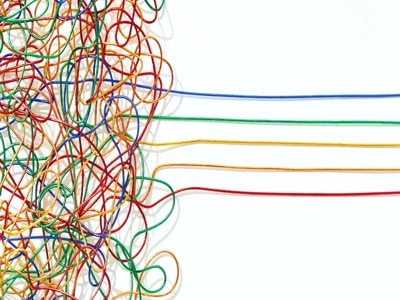
Making the move beyond technical debt requires organization-level conscious decisions that complexity and customizing are enemies of. These enemies sabotage the agility you need to simplify and modernize as a competitor in today’s digital marketplace.
Long-term digital transformation victories begin with a simpler and modern landscape as a foundation for the composable enterprise. In turn, that composable enterprise capability to rapidly assemble, disassemble, and incorporate new capabilities provides an IT-integrated business innovation foundation. And it all begins with reducing technical debt.
One of the biggest influences on the ability to build the composable enterprise of the future is how close to standard you can deploy technology. As you “get back to standard,” you gain the ability to quickly orchestrate the composable enterprise. Our approach to building a composable enterprise foundation includes scanning, filtering, evaluating, and prioritizing technology investments, beginning with the following:
Simplifying
Gain control of the legacy environment through application landscape simplification and establish the framework for the new digital era.
- Modernize.
- Integrate.
- Consolidate.
- Retire applications and application services.
The rigorous application of these listed landscape simplification items provides guideposts for digital change. We can work with you to build the future technology road map for modernization as we analyze business, financial, and operational measures.
Modernizing
Targeting “buy over build,” and sticking as close as possible to standard, enables your IT department to develop a business focus rather than a software engineering focus. You gain long-term agility advantage as you avoid customization and instead become change agents pressing for business process change. Some of the benefits include the following:
- Renting skills as needed to scale up capacity.
- Simpler and less expensive rip and replace modernization.
- Assembly of new software application capabilities inside and outside the organization, or the composable enterprise.
Application modernization is central to digital transformation and building stronger innovation capabilities. Social, Mobile, Analytics, and Cloud (SMAC) enable digital transformation in today’s competitive environment. Rather than adopting separate SMAC bolt-on applications from the past, modern applications natively integrate responsive designs. Today’s applications include mobility, deep analytics, and cloud capabilities (or are cloud extendable).
Innovating
Simplification and modernization open the door to innovation. The lack of responsiveness and agility, from technical debt customization and complex integration, jeopardize an organization’s ability to navigate the marketplace. Removing technical debt obstacles to agility, combined with ERP III capabilities such as SMAC and marketplace feedback, opens the door for market-leading innovation.
Integrating
Modern applications and landscapes provide microservices and new integration methods, tools, and standards. Future state road mapping provides the foundation for simpler and more agile integration. With a modernized landscape and limited number of applications for integration, relying on APIs, microservices, and cloud-aware enterprise service bus capabilities (for “plugging in” or replacing new capabilities) is simpler.
Transforming
The right synergies, governance, and IT integration with the business are the future of the digital economy. Achieving business and IT alignment is no longer enough; the business process nature of IT solutions requires some level of convergence. Organizational Change Management inside the IT organization and extended IT-type governance to business initiatives are past due.
Transformation requires challenges to old ways of thinking and acting. This new governance is critical to end the technical debt customization merry-go-round that plagues many landscapes today.
Running
Many organizations rely on old-style Application Managed Services (AMS), outsourcing, and simple labor arbitrage. In the modern economy, this method no longer works. Current support models do not adequately support organizational sustainability, digital transformation, digital business, customer-marketplace integration, and the digital economy.
Digital support models actively engage in continuous business transformation and innovation around new products or services. Although sales and marketing from support companies pay lip service to these requirements, that is not the delivery structure they provide.
See for yourself: Ask your existing or prospective contract support for tangible examples on how they deliver customer, product, or service outcomes in these areas. Listen carefully for the details and how those outcomes are delivered. Get past the sales or marketing hype. Listen for real-world examples that you can apply to your own business, and you will quickly discover the capability is thin at best or completely non-existent.
Making these changes is no small task, but you must do so to transition to the intelligent enterprise. Your ability to simplify and modernize directly affects business agility, marketplace responsiveness, and innovation. In a world where company lifecycles are getting shorter and shorter, businesses can no longer sustain the complexity. Your IT organization must become an extension of the business with a focus on local and regional marketplace requirements.
For additional information on Technical Debt reduction, see our PDF presentation:





